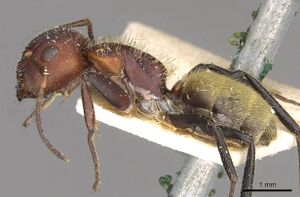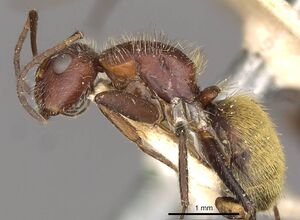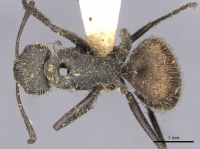Camponotus auricomus
| Camponotus auricomus | |
|---|---|

| |
| Scientific classification | |
| Kingdom: | Animalia |
| Phylum: | Arthropoda |
| Class: | Insecta |
| Order: | Hymenoptera |
| Family: | Formicidae |
| Subfamily: | Formicinae |
| Tribe: | Camponotini |
| Genus: | Camponotus |
| Species: | C. auricomus |
| Binomial name | |
| Camponotus auricomus Roger, 1862 | |
| Subspecies | |
| |
Identification
Distribution
Latitudinal Distribution Pattern
Latitudinal Range: 20.86716667° to 19.58°.
| North Temperate |
North Subtropical |
Tropical | South Subtropical |
South Temperate |
- Source: AntMaps
Distribution based on Regional Taxon Lists
Neotropical Region: Colombia, French Guiana, Greater Antilles, Guyana, Lesser Antilles, Mexico (type locality), Saint Vincent and the Grenadines, Suriname, Trinidad and Tobago.
Distribution based on AntMaps
Distribution based on AntWeb specimens
Check data from AntWeb
Countries Occupied
| Number of countries occupied by this species based on AntWiki Regional Taxon Lists. In general, fewer countries occupied indicates a narrower range, while more countries indicates a more widespread species. |

|
Estimated Abundance
| Relative abundance based on number of AntMaps records per species (this species within the purple bar). Fewer records (to the left) indicates a less abundant/encountered species while more records (to the right) indicates more abundant/encountered species. |

|
Biology
Castes
Images from AntWeb
   
| |
| Lectotype of Camponotus auricomus lucianus. Worker (major/soldier). Specimen code casent0910680. Photographer Z. Lieberman, uploaded by California Academy of Sciences. | Owned by MHNG, Geneva, Switzerland. |
   
| |
| Paralectotype of Camponotus auricomus lucianus. Worker. Specimen code casent0910681. Photographer Z. Lieberman, uploaded by California Academy of Sciences. | Owned by MHNG, Geneva, Switzerland. |
   
| |
| Lectotype of Camponotus auricomus vincentensis. Worker (major/soldier). Specimen code casent0910682. Photographer Z. Lieberman, uploaded by California Academy of Sciences. | Owned by MHNG, Geneva, Switzerland. |
   
| |
| Paralectotype of Camponotus auricomus vincentensis. Worker. Specimen code casent0910683. Photographer Z. Lieberman, uploaded by California Academy of Sciences. | Owned by MHNG, Geneva, Switzerland. |
Nomenclature
The following information is derived from Barry Bolton's Online Catalogue of the Ants of the World.
- auricomus. Camponotus auricomus Roger, 1862c: 283 (footnote) (w.q.) MEXICO (no state data).
- Type-material: syntype workers, 1 (?) syntype queen (numbers not stated).
- Type-locality: Mexico: (no further data).
- Type-depository: MNHU.
- Forel, 1879a: 98 (m.).
- Combination in C. (Myrmobrachys): Forel, 1914a: 270.
- Subspecies of senex: Forel, 1879a: 97; Emery, in Dalla Torre, 1893: 251 (footnote); Emery, 1896d: 377 (in list).
- Status as species: Roger, 1863b: 5; Mayr, 1863: 398; Mayr, 1866b: 886; Mayr, 1870a: 376 (in key); Dalla Torre, 1893: 222; Forel, 1893g: 334; Forel, 1899c: 139; Wheeler, W.M. 1918b: 27; Wheeler, W.M. 1922c: 16; Emery, 1925b: 163; Kempf, 1972a: 50; Bolton, 1995b: 87; Branstetter & Sáenz, 2012: 255; Mackay & Mackay, 2019: 753.
- Distribution: Bolivia, Colombia, Guatemala, Guyana, Mexico, Trinidad.
- Current subspecies: nominal plus lucianus, vincentensis.
Description
References
- Bolton, B. 1995b. A new general catalogue of the ants of the world. Cambridge, Mass.: Harvard University Press, 504 pp. (page 87, catalogue)
- Dalla Torre, K. W. von. 1893. Catalogus Hymenopterorum hucusque descriptorum systematicus et synonymicus. Vol. 7. Formicidae (Heterogyna). Leipzig: W. Engelmann, 289 pp. (page 222, revived status as species)
- Forel, A. 1879a. Études myrmécologiques en 1879 (deuxième partie [1re partie en 1878]). Bull. Soc. Vaudoise Sci. Nat. 16: 53-128 (page 97, race of senex)
- Forel, A. 1879a. Études myrmécologiques en 1879 (deuxième partie [1re partie en 1878]). Bull. Soc. Vaudoise Sci. Nat. 16: 53-128 (page 98, male described)
- Forel, A. 1893j. Formicides de l'Antille St. Vincent, récoltées par Mons. H. H. Smith. Trans. Entomol. Soc. Lond. 1893: 333-418 (page 334, revived status as species)
- Forel, A. 1914a. Le genre Camponotus Mayr et les genres voisins. Rev. Suisse Zool. 22: 257-276 (page 270, combination in C. (Myrmobrachys))
- Franco, W., Ladino, N., Delabie, J.H.C., Dejean, A., Orivel, J., Fichaux, M., Groc, S., Leponce, M., Feitosa, R.M. 2019. First checklist of the ants (Hymenoptera: Formicidae) of French Guiana. Zootaxa 4674, 509–543 (doi:10.11646/zootaxa.4674.5.2).
- Roger, J. 1862c. Synonymische Bemerkungen. 1. Ueber Formiciden. Berl. Entomol. Z. 6: 283-297 (page 283, (footnote) worker, queen described)
- Wetterer, J.K. 2021. Ants (Hymenoptera, Formicidae) of St. Vincent, West Indies. Sociobiology 68, e6725 (doi:10.13102/sociobiology.v68i2.6725).
References based on Global Ant Biodiversity Informatics
- Dattilo W. et al. 2019. MEXICO ANTS: incidence and abundance along the Nearctic-Neotropical interface. Ecology https://doi.org/10.1002/ecy.2944
- Dejean, A., S. Durou, I. Olmsted, R.R. Snelling and J. Orivel. 2003. Nest Site Selection by Ants in a Flooded Mexican Mangrove, with Special Reference to the Epiphytic Orchid Myrmecophila christinae. Journal of Tropical Ecology 19(3) :325-331
- Dejean, A., S. Durou, I. Olmsted, R.R. Snelling and J. Orivel. 2003. Nest Site Selection by Ants in a Flooded Mexican Mangrove, with Special Reference to the Epiphytic Orchid Myrmecophila christinae. Journal of Tropical Ecology 19(3):325-331
- Fernández, F. and S. Sendoya. 2004. Lista de las hormigas neotropicales. Biota Colombiana Volume 5, Number 1.
- Franco W., N. Ladino, J. H. C. Delabie, A. Dejean, J. Orivel, M. Fichaux, S. Groc, M. Leponce, and R. M. Feitosa. 2019. First checklist of the ants (Hymenoptera: Formicidae) of French Guiana. Zootaxa 4674(5): 509-543.
- Kempf, W.W. 1972. Catalago abreviado das formigas da regiao Neotropical (Hym. Formicidae) Studia Entomologica 15(1-4).
- Wheeler W. M. 1922. The ants of Trinidad. American Museum Novitates 45: 1-16.

